|
Contrary to the first web page in this
series, in which
I proposed Jesus Christ as a "Christ
of Peace and Conformity"---
I DO
NOT SEE JESUS AS A
GROWN
MAN, STARTING OUT
HIS
MINISTRY OR "MISSION"
TO THE
JEWISH NATION IN JUDEA
AND
GALILEE AS PROPOSING
ONLY
"PEACE AND CONFORMITY"!
Indeed, according to the
Biblical record found in Luke 4:16-30,
his first sermon in
Nazareth, preached from the book of Isaiah,
was so disturbing to his
audience, that they attempted to kill him!
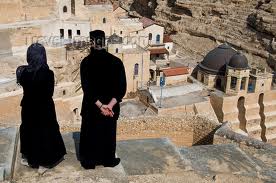 |
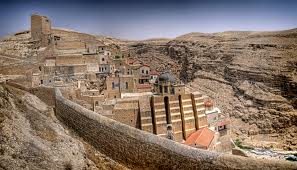 |
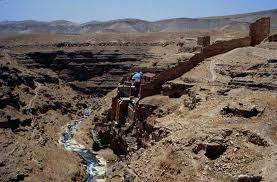 |
| What was called "Nazareth" in Jesus' time
(in the Gospels) is now Mar Saba, in the Wilderness near
Bethlehem. |
A large, sprawling, monastery for
"Nazarenes", men without women, it is maintained by Greek
Orthodox church. |
It was built on the edge of a precipice, as shown
here. One misstep can cause a person's death as they plummet
downhill. |
| Luke 4:16-30
first lets us know that Jesus was brought up, spent his earliest
years at this isolated spot, then returned as an adult, and preached
a sermon there in which he implied he was the great deliverer
promised by Isaiah in the Isaiah scroll.
He was, however, associated with a
Samaritan priest named Simon Zelotes (known as Simon Magus in
contemporary historical documents), who was a Zealot, and
another Zealot disciple named Judas Iscariot. The monks
at "Nazareth" shunned both Zealots and Samaritans, and
showed their displeasure to this young upstart leader of the Essenes.
Then Jesus launched into the second part of his sermon, recorded in
verses 23-27. "But I tell you of a truth, many
widows were in Israel in the days of Elias, when the heaven
was shut up three years and six months, when great famine was
throughout all the land. But unto none of them was Elias
(Elijah) sent, save unto Sarapta, a city of Sidon, unto a woman who
was a widow. And many lepers were in Israel in the time of
Eliseus (Elisha) the prophet; and none of them was cleansed, saving
Naaman the Syrian." [Jesus' partner
Simon Zelotes, as a Samaritan, was considered a pariah by the
Nazarenes of "Nazareth", a symbolic
"leper"] Jesus is here justifying his choice of
associates by using examples from Jewish history.
The result was a move on the part of
some of his hearers to push him over one of the walls shown above to
his death.
Luke 2:298-30 "And all
they in the synagogue, when they heard these things, were filled
with wrath, And rose up, and thrust him out of the city, and led him
unto the brow of the hill whereon their city was built, that they
might cast him down headlong, but he passing through the midst
of them went his way."

"Nazareth" on the "brow of the
hill" (in Judea, not in Galilee!) |
And indeed, during the next
3 1/2 years, Jesus continued to deal
with CONTROVERSIAL SUBJECTS
that brought him into almost
continuous conflict with the
Scribes (Sadducees) and the Pharisees,
but NOT, it seems, with the
ESSENES, who are not even mentioned
in the Gospels and in the
New Testament by that name.
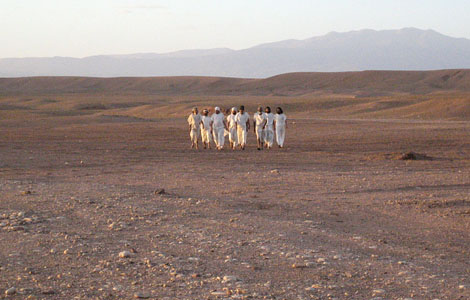
The Essenes, dressed in
their distinctive pure white garments,
periodically walked the 14
miles of desert paths up the long
hills and dry waterways from
their monastery at Qumran, and
their main fresh water
supply at Kherbit Mazin, to the city of
Jerusalem, where they
entered the Essene Gate into that city.
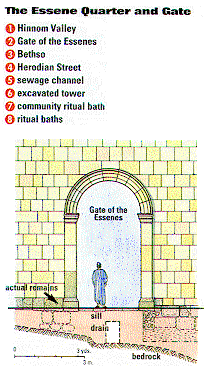
Their part of Jerusalem,
called the "Essene Quarter" was right
next to Herod's magnificent
temple, the temple that all Jews
from all over the world came
to see and worship in its courts.
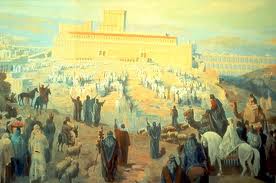
But the Essenes
refused to go into that temple. Not because
they did not think it was
beautiful, which it was. The problem, wrote
Josephus, was dead
lambs, the bloody sacrifices required of all Jews.
NEXT:
Controversial Christ in the Temple!
|






